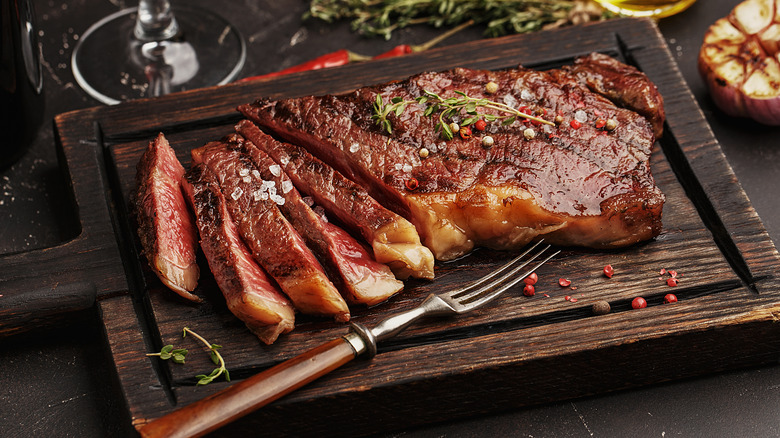Why Steakhouse Beef Usually Tastes Better Than Grocery Store Beef
There's nothing quite as decadent as eating a flawlessly cooked steak. Even if you have the grilling chops, it's nearly impossible to replicate the flavor that comes from a prime steakhouse at home. Because it all comes down to the meat. Or, more specifically, how that meat is aged. There are two ways to age meat: Dry aging and wet aging.
Cattleman's Restaurant explains that wet aging is a newer process popularized by the mass production of plastic bags. A quick and cost-effective way of aging beef, portioned meat is packed in vacuum-seal bags and refrigerated for 10 days. Naturally occurring enzymes break down the muscle, tenderizing the meat. It's quicker and, because the meat retains its water content, cheaper. (Meat is 75% water, according to the American Meat Science Association.) Most steaks found in grocery stores are wet-aged.
Walk into the best steakhouses in the world and you will see unwrapped carcasses hanging in special humidity controlled refrigerators. This is dry aging. As chef Chris Pandel of Swift and Sons Tavern in Chicago details to Robb Report, these steaks grow a layer of good mold that pulls moisture out of the meat. Katy Flannery of Flannery Beef calls this controlled decay.
When the aging process is finished, the funky bits are cut away, leaving a prime piece of deliciousness. With the moisture removed, the flavor becomes more concentrated and flavorful. Dry aging also breaks down more proteins, leading to a more tender steak.
Replicating steakhouse quality beef at home
According to Fine Cooking, you can dry-age a beef steak in your home fridge. The temperature needs to be kept below 40 degrees Fahrenheit and, since home fridges aren't as consistent as commercial ones, it's recommended to use a fridge thermometer (the perfect refrigerator temperature is between 35 F and 38 F). After confirming it can hold a consistent temp, simply buy your desired cut of meat at the local grocery store, rinse it off and dry it well, then wrap it in a triple layer of cheesecloth.
Place the wrapped cut on a wire rack, with a sheet pan under it to catch any drippings, and leave it in the refrigerator for up to seven days (Cook's Illustrated recommends placing the wrapped steak in the back of the fridge where it's coldest). Per Fine Cooking, re-wrapping the steak daily using the same cheesecloth will keep the cloth from sticking. When ready to cook, simply shave off the hard bits of fat that formed during the drying process.
Food & Wine suggests covering the beef with a generous sprinkle of salt to enhance the drying process further. After the meat ages, there's no need for fancy cooking methods. Just sear the fresh-from-the-fridge beef cut on the stovetop in a smoking hot pan before finishing it in the oven. The lack of moisture in the steak helps impart a perfect, restaurant-quality crust.

